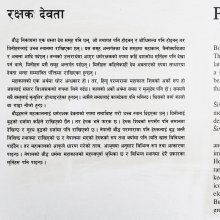Uccasthana, Uccasthāna, Ucca-sthana: 3 definitions
Introduction:
Uccasthana means something in Buddhism, Pali. If you want to know the exact meaning, history, etymology or English translation of this term then check out the descriptions on this page. Add your comment or reference to a book if you want to contribute to this summary article.
Alternative spellings of this word include Uchchasthana.
Images (photo gallery)
In Buddhism
Tibetan Buddhism (Vajrayana or tantric Buddhism)
Source: OSU Press: Cakrasamvara SamadhiUccasthāna (उच्चस्थान) refers to “(being) fixed high (on a mountain)”, according to the Cakrasaṃvara Samādhi [i.e., Cakrasamvara Meditation] ritual often performed in combination with the Cakrasaṃvara Samādhi, which refers to the primary pūjā and sādhanā practice of Newah Mahāyāna-Vajrayāna Buddhists in Nepal.—Accordingly, “Benevolence, compassion, sympathetic joy, and equanimity. Oṃ the natural state of all conditions is pure... First crossing onto a cremation ground, fixed high (uccasthāna) on a mountain, A yogi having all the sacred threads, loose hair, and facing southward, The five ambrosias and lamps, interpolated into the face”.

Tibetan Buddhism includes schools such as Nyingma, Kadampa, Kagyu and Gelug. Their primary canon of literature is divided in two broad categories: The Kangyur, which consists of Buddha’s words, and the Tengyur, which includes commentaries from various sources. Esotericism and tantra techniques (vajrayāna) are collected indepently.
Mahayana (major branch of Buddhism)
Source: De Gruyter: A Buddhist Ritual Manual on AgricultureUccasthāna (उच्चस्थान) refers to an “elevated place” (suitable for a pacification ritual), according to the Vajratuṇḍasamayakalparāja, an ancient Buddhist ritual manual on agriculture from the 5th-century (or earlier), containing various instructions for the Sangha to provide agriculture-related services to laypeople including rain-making, weather control and crop protection.—Accordingly, [As the Bhagavān teaches a pacification ritual]: “A pacification rite should be performed at four places in the field. [...] One should paint the glorious Buddha, Agastya Ṛṣi and Vajradhara and it should be mounted at the top of a flagstaff (uccasthāna) in an elevated place. Flowers and incense of offering should be given. A stake made of khadira wood measuring eight aṅgulas should be [enchanted] a thousand times and driven into the ground on the top of a dwelling. [...]”.

Mahayana (महायान, mahāyāna) is a major branch of Buddhism focusing on the path of a Bodhisattva (spiritual aspirants/ enlightened beings). Extant literature is vast and primarely composed in the Sanskrit language. There are many sūtras of which some of the earliest are the various Prajñāpāramitā sūtras.
Languages of India and abroad
Kannada-English dictionary
Source: Alar: Kannada-English corpusUccasthāna (ಉಚ್ಚಸ್ಥಾನ):—
1) [noun] a higher place, position or status.
2) [noun] (astrol.) a heavenly body’s point of greatest distance from the earth; apogee.
Kannada is a Dravidian language (as opposed to the Indo-European language family) mainly spoken in the southwestern region of India.
See also (Relevant definitions)
Relevant text
No search results for Uccasthana, Uccasthāna, Ucca-sthana, Ucca-sthāna; (plurals include: Uccasthanas, Uccasthānas, sthanas, sthānas) in any book or story.
